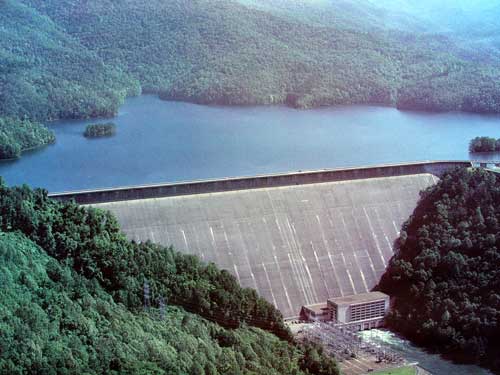A dam is an impervious hydraulic structure constructed across a river to store water on the upstream side. It acts as a barrier to form a reservoir. Dams may be classified into different categories depending upon the purpose they serve or on the basis of the material used for construction.
Types of Dams according to use
Storage dam: A storage dam is constructed to store water on its upstream side during the period of excess supply and use it during the period of scarcity.
Diversion dam: A diversion dam raises the water level slightly in the river, and thus water is diverted into a canal system. A diversion dam is always smaller in height and no reservoir is formed on its upstream to store water.
Detention dam: A detention dam is constructed to store water during floods, in order to be able to release water gradually at a safe rate when the flood recedes. By the provision of a detention dam, damages downstream due to flood are reduced.
Types of Dams according Material
Rigid dam: Rigid dams are those which are constructed of rigid material such as masonry, concrete, steel or timber.
Non-rigid dam: non-rigid dams are those which are constructed of non-rigid materials such as earth and/or rock fill.
Types of Dams according to flow condition
Overflow dam: If water is allowed to flow over the top of the dam, it is known as overflow dam. Such dams are also known as spillways. Gates are normally provided over spillways for allowing the water to pass downstream during floods and for extra storage of water after the floods.
Non-overflow dams: If water is not allowed to flow over the top of the dam, it is known as a non-overflow dam.
All the dams are generally a combination of overflow and non-overflow dams.
Gravity dams (Rigid dams)
A gravity dam is one in which the external forces (such as water pressure, silt pressure, wave pressure, etc.) are resisted by the self-weight of the dam. Thus the weight of the dam or the gravity forces maintain the stability of the dam. A gravity dam may be constructed either of masonry or concrete. Figure 1.4 shows a typical cross section of a concrete gravity dam.
The different terms of importance are as follows:
- Maximum water level or full reservoir level: The maximum level to which the water rises during the worst flood is known as the maximum water level or full reservoir level.
- Minimum pool level: The lowest water surface elevation up to which the water in the reservoir can be used is called the minimum pool level.
- Normal pool level: It is the maximum elevation to which the reservoir water surface will rise during normal operating conditions.
- Useful and dead storage: The volume of water stored in the reservoir between the minimum pool level and normal pool level is called useful storage. The volume of water stored in the reservoir below the minimum pool level is known as dead storage.
- Free board: The margin between the maximum water level and top of the dam is known as free board. Free board must be provided to avoid the possibility of water spilling over the top of the dam due to wave action.
- Drainage gallery: A gallery provided near the foundation to drain off the water which seeps through the foundation and the body of dam is called the drainage gallery.
Earth dams and rockfill dams (non-rigid dams)
Earth dams are constructed using the locally available soils and gravels; they can be used up to moderate heights only.
Earth dams may be classified into:
- Homogeneous type dams
- Zoned type dams
- Diaphragm type dams.
